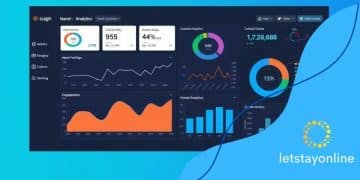How universities are using AI to improve research

Universities are using AI to improve research through enhanced data analysis, increased collaboration, personalized student engagement, and predictive analytics for funding opportunities, transforming academic practices and outcomes.
How universities are using AI to improve research is a fascinating topic that reveals innovative approaches in academia. Have you ever considered how technology transforms research practices? Let’s delve into how AI is reshaping the landscape of higher education.
AI-driven data analysis techniques
AI-driven data analysis techniques are reshaping how research is conducted in universities across the globe. With the exponential growth of data, traditional methods of analysis can be inefficient and time-consuming. As a result, integrating Artificial Intelligence into these processes is becoming essential.
One significant way AI contributes to data analysis is through machine learning algorithms. These algorithms can analyze large datasets to uncover patterns and insights that would be impossible to detect manually. This capability not only enhances the accuracy of research findings but also accelerates the time needed to reach conclusions.
Key benefits of AI in data analysis
Utilizing AI for data analysis offers several advantages:
- Improved accuracy and precision in results.
- Reduced time spent on data processing.
- Ability to analyze complex datasets easily.
- Enhanced predictive analytics for future research endeavors.
Another interesting aspect of AI-driven data techniques is natural language processing (NLP). This allows researchers to analyze unstructured data, such as articles and academic papers. By using NLP, they can extract relevant information efficiently, providing a richer understanding of existing literature without extensive manual effort.
Moreover, AI systems can assist in data visualization. By transforming complex data into visual formats, these systems help researchers interpret findings more intuitively. Visualization tools powered by AI can highlight trends, correlations, and outliers, making it easier to communicate results to a broader audience.
Universities are also exploiting the power of AI to automate repetitive tasks within the data analysis process. This means that researchers can spend more time on actual investigation and analysis, allowing for more creative and innovative research outcomes. Automating these tasks not only saves time but also minimizes the risk of human error.
Overall, AI-driven data analysis techniques are not just a trend; they are a revolution in academic research. The collaboration of AI and research methodology is paving the way for breakthroughs in various fields, from social sciences to engineering. As universities continue to embrace these technologies, we can expect even more exciting developments in the future.
Enhancing collaboration between researchers

Enhancing collaboration between researchers is becoming increasingly important in today’s academic environment. With the rise of global research initiatives, universities are embracing innovative tools that foster teamwork and idea sharing.
One effective way to enhance collaboration is through cloud-based platforms. These platforms allow researchers to work together remotely, sharing data and insights instantly. This accessibility breaks down geographical barriers, enabling teams from various locations to contribute more effectively to projects.
Key features of collaborative tools
Many modern collaboration tools offer features that can significantly improve teamwork:
- Real-time document editing and sharing.
- Integrated communication channels for instant messaging.
- Task management systems to track project progress.
- Version control to manage changes in documents.
Moreover, universities are investing in collaborative research spaces. These spaces are designed to encourage interaction between researchers from different disciplines. By working side by side, scholars can exchange ideas and spark creativity, leading to innovative solutions and discoveries.
Virtual conferences are another excellent way to facilitate collaboration. Researchers can present their work to a global audience and network with peers, which can lead to new partnerships and collaborative projects. These events highlight the significance of sharing knowledge across borders and building a community of researchers focused on similar challenges.
Additionally, mentorship programs are being tailored to promote collaboration among senior researchers and students. This not only helps students gain valuable insights and guidance from experienced professionals but also encourages a culture of collaboration within academic institutions. Such initiatives can ignite partnerships that further enrich the research experience.
In summary, enhancing collaboration between researchers is crucial for driving innovation and achieving impactful outcomes in various fields. By leveraging technology and creating supportive environments, universities can cultivate a vibrant research community that thrives on collaboration.
Automating literature review processes
Automating literature review processes is a game-changer for researchers in various fields. Traditional literature reviews can be tedious and time-consuming, often taking weeks or even months to complete. By incorporating technology, universities are streamlining this essential part of research.
One of the most effective ways to automate literature reviews is through the use of AI-powered tools. These tools can quickly scan thousands of academic articles and summarize key findings, ensuring that researchers don’t miss crucial information. This technology not only saves time but also enhances the depth of the review by identifying relevant studies that may not have been initially considered.
Benefits of AI in literature reviews
Utilizing AI in literature reviews provides several advantages:
- Increased speed in collecting and processing data.
- Higher accuracy in finding relevant literature.
- Reduction in manual data entry and error risks.
- Ability to analyze large volumes of text efficiently.
Moreover, automating these processes allows researchers to focus on more critical aspects of their studies, such as developing methodologies and analyzing results. This shift in focus can lead to higher-quality research outputs and more robust conclusions.
Another exciting development in literature review automation is the use of natural language processing (NLP). By leveraging NLP, researchers can easily filter through complex datasets and extract essential information tailored to their specific research questions. This means that literature reviews can be customized to suit individual needs, significantly improving their relevance and effectiveness.
Additionally, many universities now provide training on how to use these automated tools effectively. By understanding how to harness technology, researchers can enhance their workflow and produce literature reviews more efficiently. Such training is vital as it empowers researchers with the skills needed to navigate and implement new technologies in their work.
Overall, automating literature review processes is revolutionizing how research is conducted. By embracing these advancements, universities are not only improving their research practices but also paving the way for innovative discoveries across various disciplines.
Predictive analytics in research funding

Predictive analytics in research funding is transforming how universities approach grant applications and funding opportunities. By leveraging data-driven insights, researchers can make informed decisions that enhance their chances of securing financial support.
One of the primary benefits of predictive analytics is the ability to analyze historical funding data. Researchers can observe trends and patterns in successful grant applications, allowing them to tailor their proposals accordingly. This means they can identify which grants are most likely to fund their projects based on past outcomes.
Benefits of using predictive analytics
The advantages of predictive analytics in securing research funding include:
- Identifying potential funding sources based on previous allocations.
- Enhancing proposal quality by aligning with funders’ priorities.
- Forecasting funding trends to adapt research strategies.
- Improving collaboration between departments to pool resources effectively.
Moreover, universities can utilize machine learning algorithms to refine their funding predictions. By inputting diverse data points, such as institutional performance and researcher track records, these algorithms can generate insights that help prioritize funding applications. This process not only conserves resources but also maximizes the likelihood of obtaining necessary support.
Additionally, the integration of predictive analytics into grant management systems allows for better tracking of funding applications and outcomes. Researchers can continuously monitor their proposal’s status, learn from rejections, and improve future submissions based on analytical feedback.
By embracing these innovative approaches, universities are positioning themselves to navigate the competitive landscape of research funding more effectively. When researchers harness the power of predictive analytics, they set themselves up for greater success in their pursuit of funding and scholarly contributions.
Student engagement through AI tools
Student engagement through AI tools is becoming an essential strategy in modern education. These tools help create dynamic learning environments that keep students interested and motivated. By integrating AI into classrooms, educators can enhance the overall learning experience.
One way AI tools promote student engagement is through personalized learning experiences. These tools analyze each student’s performance, preferences, and learning styles, allowing for customized educational content. This means students can learn at their own pace, focusing on areas where they need improvement while facilitating their strengths.
Key AI tools for student engagement
Various AI tools have been developed to foster better engagement:
- Intelligent tutoring systems that offer personalized feedback and support.
- Gamification platforms that use game design elements to motivate students.
- Chatbots that provide on-demand assistance and answer questions.
- Adaptive learning software that adjusts educational materials based on student learning speeds.
Additionally, AI tools can facilitate collaboration among students. For example, platforms that use AI to group students based on similar interests or complementary skills can spark discussions and collaborative projects. This interaction not only enhances learning but also builds essential teamwork abilities.
Another exciting innovation is the use of data analytics to track student engagement levels. Teachers can receive insights about which activities or subjects captivate their students the most. With this information, educators can modify their lesson plans to incorporate more engaging content, keeping student interest high throughout the course.
Moreover, AI can help bridge gaps in education by providing resources and support for students who may be struggling. Tools that analyze individual challenges allow for targeted interventions, ensuring that no student falls behind. By addressing their needs directly, AI fosters a more inclusive learning environment.
In summary, student engagement through AI tools is significantly transforming educational practices. By harnessing the power of technology, universities can create vibrant and responsive learning atmospheres that benefit both students and educators.
FAQ – Frequently Asked Questions about AI in University Research
How does AI improve the research process in universities?
AI enhances research by streamlining data analysis, improving collaboration, and automating literature reviews, leading to faster and more accurate results.
What are some popular AI tools for student engagement?
Popular AI tools include intelligent tutoring systems, gamification platforms, and adaptive learning software, all designed to personalize and enhance learning experiences.
How can predictive analytics help in research funding?
Predictive analytics can identify funding opportunities based on historical data, helping researchers understand which grants are aligned with their projects.
What benefits do AI-driven collaboration tools offer?
AI-driven collaboration tools enhance teamwork between researchers by providing real-time communication and resource sharing, leading to accelerated project outcomes.






